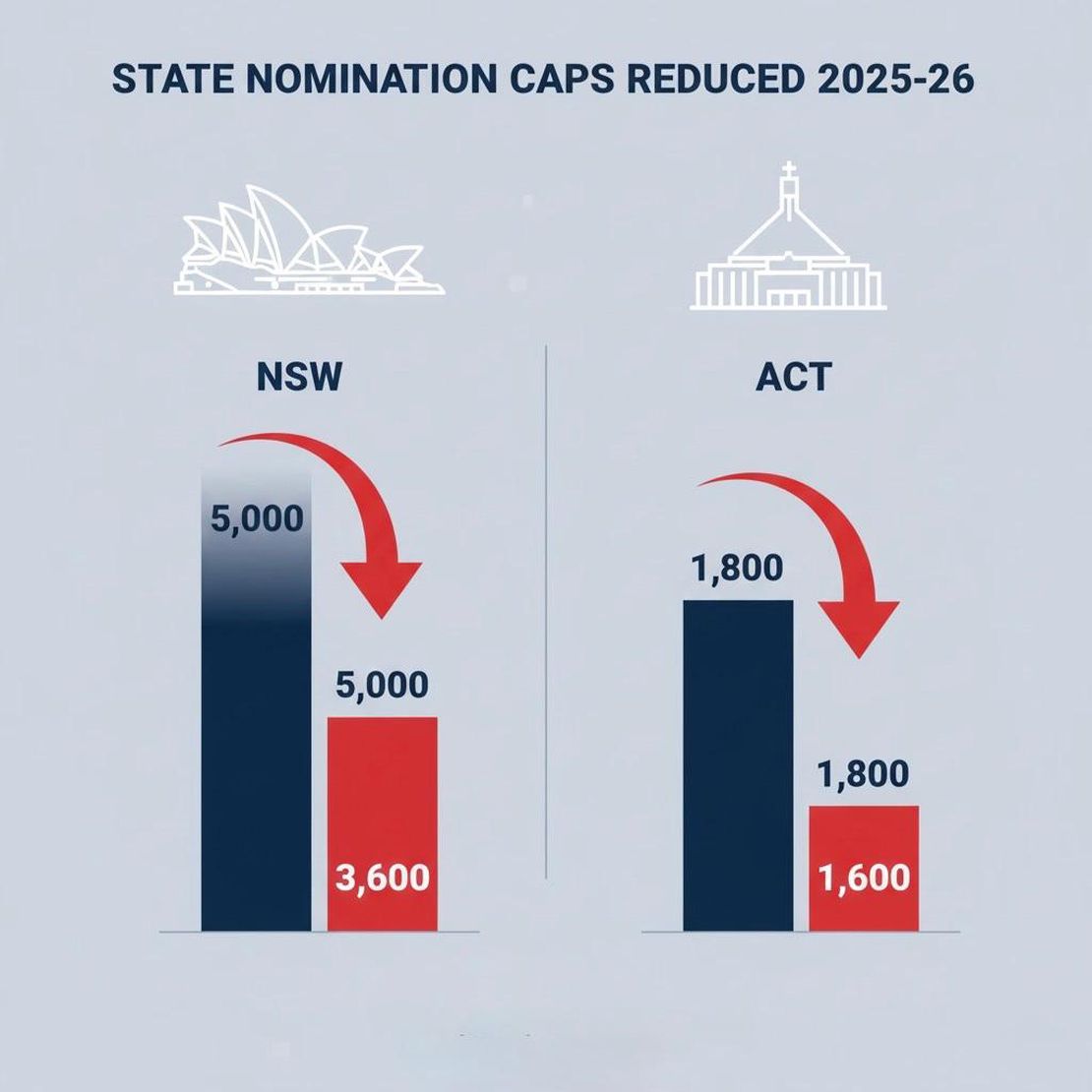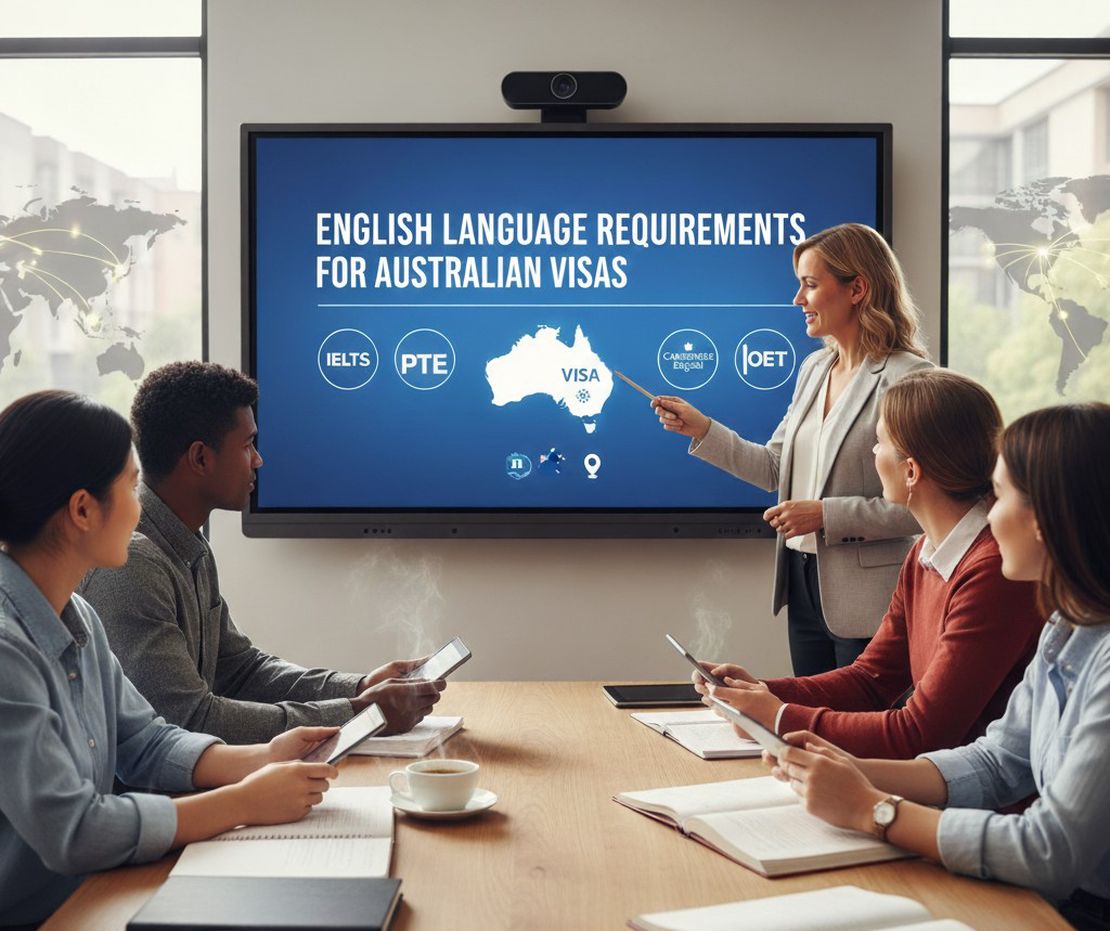In line with updates from other states, New South Wales (NSW) and the Australian Capital Territory (ACT) have announced their skilled migration allocations for the 2025-26 program year. Both jurisdictions face reduced nomination places compared to the previous year, reflecting the Commonwealth Government’s overall migration strategy.
NSW (New South Wales) Allocation
The NSW Government has received a total allocation of 3,600 nomination places for the 2025-26 program year, representing a significant reduction from the 5,000 places allocated in 2024-25.
NSW Allocation Breakdown
Total allocation: 3,600 places
- 2,100 places – Skilled Nominated (Subclass 190)
- 1,500 places – Skilled Work Regional (Subclass 491)
This 28% reduction from last year’s allocation means NSW will need to prioritize candidates more carefully across both visa pathways. The state typically focuses on skilled professionals in critical sectors including healthcare, engineering, ICT, and construction.
ACT (Australian Capital Territory) Allocation
The ACT has received a total allocation of 1,600 nomination places for 2025-26, down from 1,800 places in the previous program year.
ACT Allocation Breakdown
Total allocation: 1,600 places
- 800 places – Skilled Nominated (Subclass 190)
- 800 places – Skilled Work Regional (Subclass 491)
The ACT has split its allocation evenly between permanent and provisional visa pathways, with the 11% reduction reflecting the tighter national migration program settings.
ACT Invitation Round Status
The ACT Government is currently scheduling its next invitation round, with details to be published on the official ACT Canberra Matrix website once finalized. Prospective applicants should monitor the official channels for announcement of invitation dates and any updated selection criteria.
Comparing 2024-25 vs 2025-26 Allocations
Understanding year-over-year changes helps applicants gauge competitiveness:
| State | 2024-25 Total | 2025-26 Total | Change | Subclass 190 | Subclass 491 |
|---|---|---|---|---|---|
| NSW | 5,000 | 3,600 | -28% | 2,100 | 1,500 |
| ACT | 1,800 | 1,600 | -11% | 800 | 800 |
Both jurisdictions face reduced capacity, which will likely result in:
- Higher points thresholds for competitive occupations
- Stricter selection criteria
- Increased focus on state-specific factors
- Longer processing times due to higher application volumes relative to available places
What This Means for Applicants
For NSW Applicants
With fewer nomination places available, NSW applicants should focus on:
Strengthening state connections:
- Current employment in NSW (most competitive factor)
- NSW educational qualifications
- Family ties to NSW
- Job offers from NSW employers
Maximizing points:
- Target Proficient or Superior English for maximum points
- Consider NAATI CCL for 5 bonus points
- Ensure skills assessment covers all relevant experience
- Calculate your score with our Points Calculator
Priority occupations: NSW typically prioritizes occupations aligned with state workforce needs, including:
- Registered Nurses and Healthcare Professionals
- Software Engineers and ICT Professionals
- Civil and Mechanical Engineers
- Teachers (especially in regional areas)
- Construction Project Managers
For ACT Applicants
The ACT operates a unique Matrix system that requires strategic planning:
Understanding the Canberra Matrix:
- Points-based system separate from federal points
- Strong emphasis on ACT residence and employment
- Additional points for ACT study and family connections
- Monthly or bi-monthly invitation rounds (schedule varies)
Improving your Matrix score:
- Secure ACT employment (most heavily weighted)
- Consider ACT study pathways if eligible
- Build time in ACT if already onshore
- Ensure English scores are maximized
ACT-specific strategies:
- Monitor the Matrix minimum scores published after each round
- Keep your Canberra Matrix profile updated
- Respond promptly to any ACT Government requests
- Demonstrate genuine commitment to settling in ACT
Regional Opportunities: Subclass 491 Pathway
Both NSW and ACT allocate substantial places to the Subclass 491 visa, offering an alternative pathway for skilled migrants willing to commit to regional areas.
Benefits of the 491 Pathway
Higher points boost:
- 15 points added to your score (vs. 5 points for 190)
- Makes qualification easier for those with lower base points
Pathway to permanent residence:
- After 3 years on 491 visa, eligible for Subclass 191 Permanent Residence
- Must meet minimum income requirements
- Must maintain regional residence during provisional period
Regional NSW considerations:
- All of NSW except Sydney, Newcastle, and Wollongong
- Check regional postcodes to confirm eligibility
- Strong employment opportunities in regional cities like Wagga Wagga, Albury, Dubbo
Regional ACT considerations:
- All of ACT qualifies as regional for 491 purposes
- Provides full federal services and amenities
- Access to quality education and healthcare
National Context: 2025-26 Migration Program
These state allocations sit within the broader 2025-26 Migration Program framework announced by the Commonwealth Government.
Key Features of 2025-26 Program
Total planning level: 185,000 permanent migration places
Skill stream focus: Approximately 70% of total program dedicated to skilled migration
State and territory distribution: States receive allocations based on:
- Economic contribution capacity
- Population size
- Regional development priorities
- Previous utilization rates
How Other States Compare
For context on how NSW and ACT allocations fit nationally:
Victoria: Received interim allocation, full allocation details pending
South Australia: Operating with limited interim allocations
Queensland: Full program details released with comprehensive occupation lists
Application Process Overview
NSW State Nomination Process
Submit SkillSelect EOI
- Indicate NSW as preferred state
- Ensure minimum 65 points (before state nomination)
- Select appropriate visa subclass (190 or 491)
Monitor NSW invitation channels
- NSW operates on-demand invitation system
- Check email and SkillSelect account regularly
- Be ready to respond within invitation timeframe
Prepare documentation
- Skills assessment
- English test results
- Employment references
- NSW connection evidence
Submit state nomination application
- Complete within invitation deadline
- Pay nomination fee
- Upload all supporting documents
ACT Canberra Matrix Process
Create Canberra Matrix account
- Complete detailed profile
- Provide evidence of ACT connections
- Calculate Matrix points
Submit SkillSelect EOI
- Link to Canberra Matrix profile
- Indicate ACT as preferred territory
- Maintain accuracy across both systems
Await invitation round
- ACT publishes minimum scores after each round
- Invitations issued to highest-ranking candidates
- Separate pools for 190 and 491
Lodge nomination application
- Follow ACT-specific requirements
- Provide evidence matching Matrix claims
- Respond to any requests promptly
Strategic Timing Considerations
When to Apply
Immediate application recommended if:
- You already meet high competitiveness thresholds
- You have strong state connections (current employment, study)
- Your occupation is on priority lists
- Your documents are current and ready
Consider strengthening profile first if:
- Points are marginal
- English scores can be improved
- Additional work experience will benefit application
- State connections can be established
Document Validity
Ensure all documents remain valid throughout the process:
Skills assessment:
- Check validity period with assessing authority
- Some professions require recent assessments
English tests:
- Valid for 3 years from test date
- Consider new test options available from August 2025
Police clearances:
- Required at visa stage
- Must be less than 12 months old
Health examinations:
- Valid for 12 months
- Arranged after visa invitation
Frequently Asked Questions
Do I need a job offer to apply?
NSW: Job offers are not mandatory but significantly strengthen applications, especially for subclass 190. Some occupations or pathways may require employment.
ACT: Current ACT employment is the highest-weighted factor in the Canberra Matrix. While technically possible to gain points without employment, it dramatically improves competitiveness.
Can I apply to multiple states simultaneously?
Yes, you can indicate interest in multiple states in your SkillSelect EOI. However, each state has its own requirements and selection processes. Focus your efforts on states where you have the strongest connections and competitiveness.
What if I don’t receive an invitation this year?
Your SkillSelect EOI remains valid for up to 2 years. During this time:
- Continue improving your points
- Gain additional work experience
- Retake English tests for higher scores
- Consider alternative pathways like employer sponsorship
- Monitor for policy changes that might benefit your case
How long does the entire process take?
Typical timeline:
- EOI to state invitation: 1-6 months (varies significantly)
- State nomination processing: 6-12 weeks
- Visa application processing: 8-12 months
- Total: 12-24 months from EOI to visa grant
Are there age limits?
You must be under 45 years of age when you receive your invitation to apply for the visa (not when you submit EOI or nomination application). Age is a critical factor - losing points due to aging can impact your competitiveness.
What happens if allocations are exhausted?
If state allocations are fully utilized before the end of the program year:
- Invitations will pause until new allocations are provided
- Your EOI remains active for consideration when invitations resume
- States may prioritize highest-ranking candidates when invitations recommence
Alternative Pathways to Consider
Given the reduced allocations, consider these complementary strategies:
Employer Sponsorship
If you have or can secure Australian employer support:
- Subclass 482 Temporary Skill Shortage visa
- Subclass 186 Employer Nomination Scheme
- May offer faster processing than state nomination
- Different eligibility requirements and obligations
Federal Skilled Migration
For highly competitive candidates:
- Subclass 189 Skilled Independent visa
- No state nomination required (no state residence obligations)
- Requires very high points (typically 95+)
- Recent invitation rounds detailed in our November 2025 invitaion round
Innovation Visa
For exceptional talent in specific fields:
- Subclass 858 National Innovation Visa
- Focus on researchers, entrepreneurs, investors, and exceptional talent
- No state nomination or points test required
- Requires demonstration of outstanding achievements
Monitoring for Updates
Official Information Sources
Stay informed through authoritative channels:
NSW specific:
- NSW Migration website
- Subscribe to updates for invitation announcements
ACT specific:
- Canberra - Your Future
- ACT Canberra Matrix portal notifications
Federal government:
What to Watch For
Key announcements to monitor throughout 2025-26:
- ACT invitation round dates - Published before each round
- NSW invitation updates - May be announced periodically
- Occupation list changes - Both states may adjust priorities
- Policy updates - Changes to eligibility or selection criteria
- Allocation utilization rates - Some states publish quarterly data
- Federal policy changes - May impact state nomination programs
Key Takeaways
- Reduced allocations: Both NSW (down 28%) and ACT (down 11%) face tighter nomination capacity in 2025-26
- Increased competition: Fewer places mean higher thresholds and stricter selection
- State connections matter: Employment, study, and genuine commitment to the state are critical
- Strategic preparation: Maximize points, update documentation, and strengthen state ties
- Regional opportunities: 491 pathway offers alternative route with 15 bonus points
- Stay informed: Monitor official channels for invitation rounds and policy updates
- Consider alternatives: Employer sponsorship and federal pathways remain viable options
Next Steps
Immediate Actions
For prospective NSW applicants:
- Check your points score and competitiveness
- Research NSW employer connections or job opportunities
- Ensure all documents are current and valid
- Submit SkillSelect EOI if not already done
- Monitor NSW migration website for updates
For prospective ACT applicants:
- Create or update your Canberra Matrix profile
- Calculate your Matrix points accurately
- Build ACT connections if possible (employment, study, family)
- Watch for next invitation round announcement
- Prepare evidence of all claimed Matrix points
Long-term Planning
While awaiting invitation:
- Continue gaining skilled employment experience
- Pursue higher English test scores
- Research Australian licensing requirements for your occupation
- Network with professional associations in your target state
- Consider upskilling through additional certifications
- Build familiarity with NSW or ACT job markets
Alternative strategies:
- Explore employer sponsorship options
- Research other state nomination programs
- Consider regional opportunities in less competitive states
- Investigate federal skilled migration pathways
Conclusion
The announcement of NSW and ACT skilled migration allocations for 2025-26 brings clarity to thousands of prospective migrants planning their Australian journey. While the reduced allocations present increased competition, both states continue to welcome skilled professionals who can contribute to their economies and communities.
Success in this competitive environment requires thorough preparation, maximized points, genuine state connections, and strategic timing. Whether targeting NSW’s diverse economy or ACT’s unique Canberra Matrix system, understanding each jurisdiction’s priorities and requirements is essential.
The key to navigating reduced allocations is proactive preparation. Strengthen your profile now, monitor official channels regularly, and be ready to respond quickly when opportunities arise. For those willing to commit to regional areas, the 491 pathway offers additional opportunities with a clear pathway to permanent residence.
Remember that state nomination is one of several pathways to Australian permanent residence. If NSW or ACT prove highly competitive for your occupation, consider diversifying your strategy across multiple states or exploring alternative visa pathways that align with your circumstances and goals.
Last updated: November 7, 2025. This article is based on information available at the time of publication. Always refer to official NSW and ACT government websites for the most current information. For personalized advice about your specific circumstances, contact our registered migration agents.
This article is for general information only. For specific advice about your circumstances, consult a registered migration agent.





